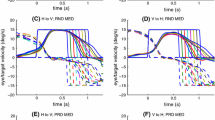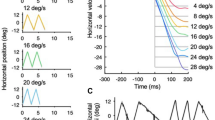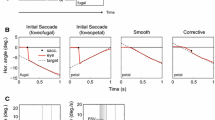Abstract
We investigated the ability to generate anticipatory smooth pursuit to sequences of constant velocity (ramp) stimuli of increasing complexity. Previously, it was shown that repeated presentation of sequences composed of four ramps with two speeds in two directions, evoked anticipatory smooth pursuit after only one or two presentations. Here, sequences of four or six ramps, each having a choice of four speeds and either one or two directions (uni- or bi-directional) were examined. The components of each sequence were presented as discrete ramps (duration: 400 ms; randomised velocity: 10–40°/s), each starting from the centre with 1,200 ms periods of central fixation between ramps, allowing anticipatory activity to be segregated from prior eye movement. Auditory warning cues occurred 600 ms prior to each target presentation. Anticipatory smooth eye velocity was assessed by calculating eye velocity 50 ms after target onset (V 50), prior to the availability of visual feedback. Despite being required to re-fixate centre during inter-ramp gaps, subjects could still generate anticipatory smooth pursuit with V 50 comparable to single speed control sequences, but with less accuracy. In the steady state V 50 was appropriately scaled in proportion to upcoming target velocity for each ramp component and thus truly predictive. Only one to two repetitions were required to attain a steady-state for unidirectional sequences (four or six ramps), but three or four repeats were required for bi-directional sequences. Results suggest working memory can be used to acquire multiple levels of velocity information for prediction, but its use in rapid prediction is compromised when direction as well as speed must be retained.





Similar content being viewed by others
References
Bahill AT, McDonald JD (1983) Model emulates human smooth pursuit system producing zero-latency target tracking. Biol Cybern 48:213–222
Barnes GR, Asselman PT (1991) The mechanism of prediction in human smooth pursuit eye movements. J Physiol (Lond) 439:439–461
Barnes GR, Asselman PT (1992) Pursuit of intermittently illuminated moving targets in the human. J Physiol (Lond) 445:617–637
Barnes GR, Donelan AS (1999) The remembered pursuit task: evidence for segregation of timing and velocity storage in predictive oculomotor control. Exp Brain Res 129:57–67
Barnes GR, Schmid AM (2002) Sequence learning in human ocular smooth pursuit. Exp Brain Res 144:322–35
Becker W, Fuchs AF (1985) Prediction in the oculomotor system: smooth pursuit during transient disappearance of a visual target. Exp Brain Res 57:562–575
Bennett SJ, Barnes GR (2003) Human ocular pursuit during the transient disappearance of a moving target. J Neurophysiol 90:2504–2520
Bennett SJ, Barnes GR (2004) Predictive smooth ocular pursuit during the transient disappearance of a visual target. J Neurophysiol 92:578–590
Boman DK, Hotson JR (1992) Predictive smooth pursuit eye movements near abrupt changes in motion direction. Vis Res 32:675–689
Carl JR, Gellman RS (1987) Human smooth pursuit: stimulus-dependent responses. J Neuro Physiol 57:1446–1463
Chakraborti SR, Barnes GR, Collins CJS (2002) Factors affecting the longevity of a short-term velocity store for predictive oculomotor tracking. Exp Brain Res 144(2):152–158
Churchland MM, Chou I-H, Lisberger SG (2003) Evidence for object permanence in the smooth-pursuit eye movements of monkeys. J Neurophysiol 90:2205–2218
Collins CJS, Turner JP, Barnes GR (2003) Scaling of anticipatory smooth eye velocity in response to sequences of discrete target movements in Humans. Soc Neurosci Abstr 603.9
Gaymard B, Pierrot-Deseilligny C, Rivaud S (1990) Impairment of sequences of memory-guided saccades after supplementary motor area lesions. Ann Neurol 28:622–626
Greenlee MW, Lang HJ, Mergner T, Seeger W (1995) Visual short term memory of stimulus velocity in patients with unilateral posterior brain damage. J Neurosci 15:2287–2300
Helmuth LL, Mayr U, Daum I (2000) Sequence learning in Parkinson’s disease: a comparison of spatial-attention and number-response sequences. Neuropsychologia 38:1443–1451
Heywood S, Churcher J (1971) Eye movements and the afterimage-1 tracking the afterimage. Vis Res 11:1163–1168
Jarrett CB, Barnes GR (2002) Volitional scaling of anticipatory ocular pursuit velocity using precues. Cogn Brain Res 14:383–388
Kao GW, Morrow MJ (1994) The relationship of anticipatory smooth eye movement to smooth pursuit initiation. Vis Res 34:3027–3036
Kowler E, Steinman RM (1979a) The effect of expectations on slow oculomotor control-I Periodic target steps. Vis Res 19:619–632
Kowler E, Steinman RM (1979b) The effect of expectations on slow oculomotor control-II single target displacements. Vis Res 19:633–646
Kowler E, Steinman RM (1981) The effect of expectations on slow oculomotor control III guessing unpredictable target displacements. Vis Res 21:191–203
Krauzlis RJ, Miles FA (1996) Transitions between pursuit eye movements and fixation in the monkey: dependence on context. J Neurophysiol 76:1622–1638
LaMendola NP, Zaksas D, Pasternak T (2004) Neurons in preforntal cortex are active during a working memory for visual motion task. Soc Neurosc Abstr:527.524
Levy R, Goldman-Rakic PS (2000) Segregation of working memory functions within the dorsolateral prefrontal cortex Exp Brain Res 133:23–32
Lisberger SG, Fuchs AF (1978) Role of primate flocculus during rapid behavioural modification of vestibuloocular reflex I Purkinje cell activity during visually guided horizontal smooth-pursuit eye movements and passive head rotation. J Neurophysiol 41:733–763
Nissen MJ, Bullemer P (1987) Attentional requirements of learning: Evidence from performance measures. Cogn Psychol 19:1–32
von Noorden GK, Mackensen G (1962) Pursuit movements of normal and amblyopic eyes—an electro-ophthalmographic study 1 Physiology of pursuit movements. Am J Ophthalmol 53:325–336
Ohashi N, Barnes GR (1996) A comparison of predictive and non-predictive ocular pursuit under active and passive stimulation conditions in humans. J Vestib Res 6:261–276
Petit L, Orssaud C, Tzourio N, Crivello F, Berthoz A, Mazoyer BM (1996) Functional anatomy of a pre-learned sequence of horizontal saccades in humans. J Neurosci 16:3714–3726
Rashbass C (1961) The relationship between saccadic and smooth tracking eye movements. J Physiol (Lond) 159:326–338
Robinson DA (1982) A model of cancellation of the vestibulo-ocular reflex. In: Lennerstrand G, Zee DS, Keller EL (eds) Functional basis of ocular motility disorders. Pergamon Press, Oxford, pp 5–13
Tanaka M, Fukushima K (1997) Slow eye movement evoked by sudden appearance of a stationary visual stimulus observed in a step-ramp smooth pursuit task in monkey. Neurosci Res 29:93–98
Tanaka M, Lisberger SG (2000) Context-dependent smooth eye movements evoked by stationary visual stimuli in trained monkeys. J Neurophysiol 84:1748–1762
Willingham DB, Wells LA, Farrell JM, Stemwedel ME (2000) Implicit motor sequence learning is represented in response locations. Mem Cognit 28:366–375
Acknowledgements
This work was supported by the Medical Research Council, UK.
Author information
Authors and Affiliations
Corresponding author
Rights and permissions
About this article
Cite this article
Collins, C.J.S., Barnes, G.R. Scaling of smooth anticipatory eye velocity in response to sequences of discrete target movements in humans. Exp Brain Res 167, 404–413 (2005). https://doi.org/10.1007/s00221-005-0044-8
Received:
Accepted:
Published:
Issue Date:
DOI: https://doi.org/10.1007/s00221-005-0044-8




